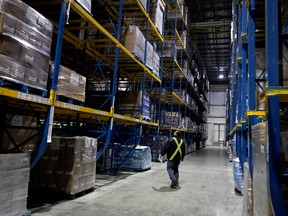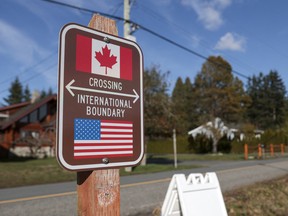You’ve probably never heard of it, but without it there’d be a lot fewer Christmas cookies
Article content
Inside a warehouse in a suburb east of Montreal, there are hundreds of thousands of kilograms of butter, one-pound bricks for grocery stores and 25-kilogram slabs for commercial bakeries, all kept on pallets that are so heavy the racks need to be reinforced with steel to hold them.
Advertisement 2
Article content
This butter, stacked to the roof and kept at -18C in Sainte-Julie, Que., is the property of a federal Crown corporation. The Canadian Dairy Commission (CDC), created in the mid-1960s to manage the national supply of milk, maintains a reserve of frozen butter, held in 18 warehouses around the country, mostly just to stay on top of demand from the annual surge in holiday baking.
Article content
At its peak, the national stockpile of butter weighs roughly the same as a herd of 2,500 elephants — enough butter to give a pound to every person in Canada.
The CDC says the program is meant to solve a simple problem. Cows don’t produce milk evenly throughout the year. There are ebbs and flows, and those patterns don’t line up with when consumers want butter the most. Cows thrive in colder weather, so they make more milk in the winter and spring. But demand doesn’t start to peak until the fall, around September, when food manufacturers ramp up production on their holiday lines.
Advertisement 3
Article content
That’s the sort of mismatch that leads to farmers dumping their milk in spring, and bakers running out of butter in fall, or at least that’s what the CDC is afraid of.
“Whenever there is a litre of milk being dumped, you know, we go crazy,” said Christine Boutin, CDC’s senior director of commercial operations and marketing.
Whenever there is a litre of milk being dumped, you know, we go crazy
Christine Boutin
So the commission buys excess butter from dairy processors when no one else wants it, at a set price of about $10 per kilogram, and stores it in third-party warehouses around the country. When demand ramps up, the CDC sells it back to the processors at the same price.
Officially, the reserves are known as the Domestic Seasonality Program. It’s probably the dullest way you could ever describe a project like this, and that helps explain why so few people have heard of it. But whatever you call it, the point is to guard against the sort of anxiety that gripped bakers in the United States this fall, when dairy companies warned that low milk production and job vacancies could lead to a holiday butter shortage, as the Wall Street Journal reported.
Advertisement 4
Article content
At the warehouse in Sainte-Julie, the manager wandered through the aisles staring at a map that marked which pallets were government butter, and which pallets belonged to his other clients. The place looked a lot like the backend of an Ikea, except it was punishingly cold — so cold that on hot days, “guys come in and out of there and they’re steaming like hotdogs,” said the manager, James Miele, who works for Congebec Inc., the Quebec City-based refrigerated warehousing company that stores butter for the CDC.
Wall of butter
Miele led us to the back of the warehouse and waved at an aisle. All of it, he said, was part of the reserve.
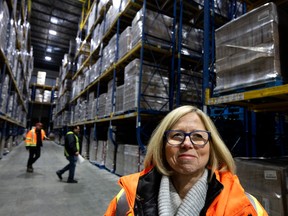
There was a wall of butter on both sides, rising 40 feet to the ceiling. All of it was packed in boxes and the boxes were fitted together onto pallets, like big brown Rubik’s Cubes, each one weighing about 2,200 kilograms. And that was just one aisle of one warehouse out of about 18, on one day in early December, after many of the dairy companies had already drawn on the reserve for the holidays.
Advertisement 5
Article content
Depending on the season, the butter reserves across the country can hold as much as eight to 15 per cent of Canada’s annual butter production. Last year, Canada produced 117,406 tonnes, according to Statistics Canada. So that means there could be as much as 17,611 tonnes held in reserve, or 39 million pounds. (An average male elephant weighs about seven tonnes.)
Simon Somogyi, a professor who specializes in the business of food at the University of Guelph, wondered whether that was overkill.
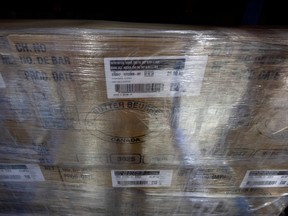
“The electricity. The salaries and wages,” he said. “It must be a multi-million-dollar industry to keep reserves and manage and support those reserves, which then leads to the question: How much reserve is enough?”
The cost of warehousing the butter ultimately falls to the consumer, the CDC confirmed. It works out to about half a cent per pound of butter, said spokesperson Chantal Paul.
Advertisement 6
Article content
Quirk of the system
It’s not out of the ordinary for governments to stockpile commodities. Starting in the 1970s, the European Union built a “butter mountain” of surplus dairy that, as of 2017, had reportedly dried up. China stockpiles pork. And famously, the U.S. started bailing out farmers by turning excess milk into “government cheese” under President Jimmy Carter.
Evan Fraser, director of the University of Guelph’s Arrell Food Institute, said government reserves have fallen out of favour in the age of the global marketplace, written off “as expensive and generally inefficient.” After flash food shortages brought on by the pandemic and the war in Ukraine, however, reserve systems might be getting a second look, he said in an email.
Advertisement 7
Article content
Canada’s butter reserve is a quirk of the government’s supply management rules, and has been around, in some form, for decades. Since the middle of the last century, Ottawa has protected a handful of commodities — poultry, dairy and eggs — from the whims of the open market. The idea is that by setting prices and controlling how much is produced, the government can strike a balance between supply and demand, guaranteeing that farmers get a stable price and Canadian grocery stores don’t have to contend with shortages.
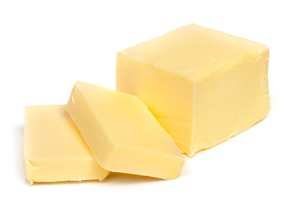
In the dairy sector, the CDC is in charge of setting those quotas and prices, including the price for butter going in and out of the reserve. That process can be controversial. Last year, critics accused the CDC of being too secretive, after a series of major increases to the price of raw milk, and butter, during the inflation crisis.
Advertisement 8
Article content
The CDC has been stockpiling butter since its inception in the mid-1960s, according to a 2006 history of the dairy commission. The book reports that in 1967, the CDC’s first year in existence, it bought 1,016 tonnes of butter from New Zealand out of fear there might be shortages that year.
But in 2022, butter from New Zealand has become a bit of a sore subject. As part of supply management rules, the government stops international challengers from undercutting Canadian farmers by slapping high tariffs on imported dairy.
The policy has annoyed some of our trading partners, especially New Zealand and the U.S. Both countries have launched formal disputes with Canada, accusing Ottawa of stubbornly sticking to its protectionist ways and using loopholes in trade agreements to limit the flow of foreign butter and cheese it has to allow into the country.
Advertisement 9
Article content
Cows like it cold
One of the biggest dairy processors in Canada, Agropur Dairy Cooperative, is happy with how the system is working. The dairy giant produces the Natrel brand of butter. Its production peaks in the spring, as more farms pump out more milk.
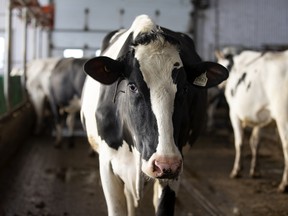
The reason for that fluctuation in milk production has to do with weather. “When it gets cold, they eat more, and when they eat more, they milk more,” said Stephen LeBlanc, a veterinary professor who leads the University of Guelph’s Centre for Dairy Research and Innovation.
Agropur doesn’t have a market for all its spring butter, so it sells a “large portion” to the CDC reserve program, spokesperson Dominique Benoit said. “We buy back in the fall.”
When the orders start coming in, Agropur sends trucks to collect the pallets of Natrel, or the suitcase-sized slabs of commercial butter in blue food-safe bags, and delivers them to the supermarket distribution centre or factory that needs it.
Advertisement 10
Article content
-

The man who bought Celine Dion’s Nickels deli could be coming for your favourite restaurant chain next
-

Canada’s lettuce problem: What a $15 bag of romaine says about our food system
-

How something as common as rain in Vancouver can send shockwaves through Canada’s entire food system
-

The very Canadian problem at the heart of our supply chain woes
The processor depends on the program to the point that without it, Benoit said, “we would have a hard time supplying our market in the fall.”
So it stands to reason that if you are baking this season, there’s a good chance your butter has spent some time in limbo, locked in a government-leased purgatory, somewhere in between the creamery and the supermarket, waiting in a a cold, dark warehouse until somebody, somewhere wanted it again.
• Email: jedmiston@postmedia.com | Twitter: jakeedmiston
Advertisement
Inside Canada’s national butter reserve that ensures holiday baking
2022-12-23 15:14:51


